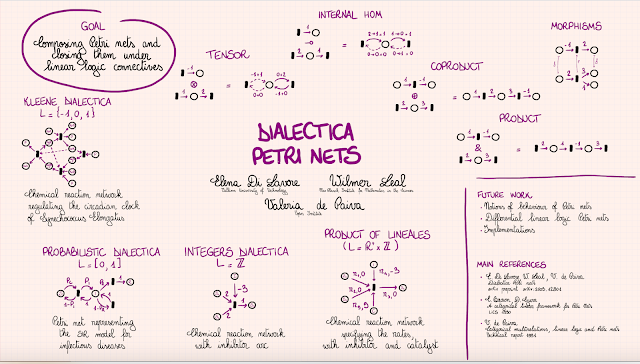This beautiful poster presented by Elena at the ACT poster session is a great summary of the work that went into the arXiv preprint of ours Dialectica Petri Nets (Elena di Lavore, Wilmer Leal, Valeria de Paiva). But a 2 min presentation, even if impeccably given, like Elena did it at the Applied Category Theory Conference, does not do justice to the work.
This work started for the ACT Summer School last year. Summer Schools can be fraught with difficulties, as people do not know what to expect from them. I had decided to play it safe and to have a few meetings before the official start of the School, so Jade Master, Elena di Lavore, Xiaoyan Li and I met a few times to talk about the readings. I had a great time with these meetings and only realized later on that two other members of the team (Wilmer Leal and Eigil Rischel) were missing!
The School itself was complicated by COVID-19 and the first "Shelter in place" or "LockDown" or whatever you want to call it. Also because the School had a team in Australia the logistics were more complicated, as covering West Coast, Europe and Australia is complicated. Both West Coast and Europe and West Coast and Australia are ok, but the three together does not seem to work very well. Someone has to suffer in the middle of the night.
Elena Di Lavore and Xiaoyan Li wrote their piece Linear Logic Flavoured Composition of Petri Nets as a guest post for The n-Category Café and some good discussion happened. I must confess that this work went into a different direction than the one I had envisaged. Which is great, this is why we have collaborations. But I had imagined that we would do much work connecting this LL-based version of Petri nets to other categories of Petri nets, trying to suss out advantages and disadvantages of different categorical models. Instead the group seemed much more interested in discussing different kinds of connections or edges in a given Petri Net (namely probabilistic edges, multiple-valued logic edges, multiplicity enhanced edges, etc..) and how we could put these kinds of links together. This was caused by the disposition of actually using these nets in Chemistry and Bioinformatics and these proposed applications are extremely cool!

No comments:
Post a Comment